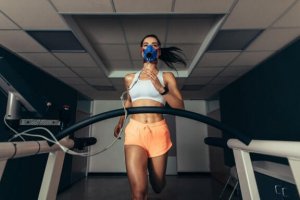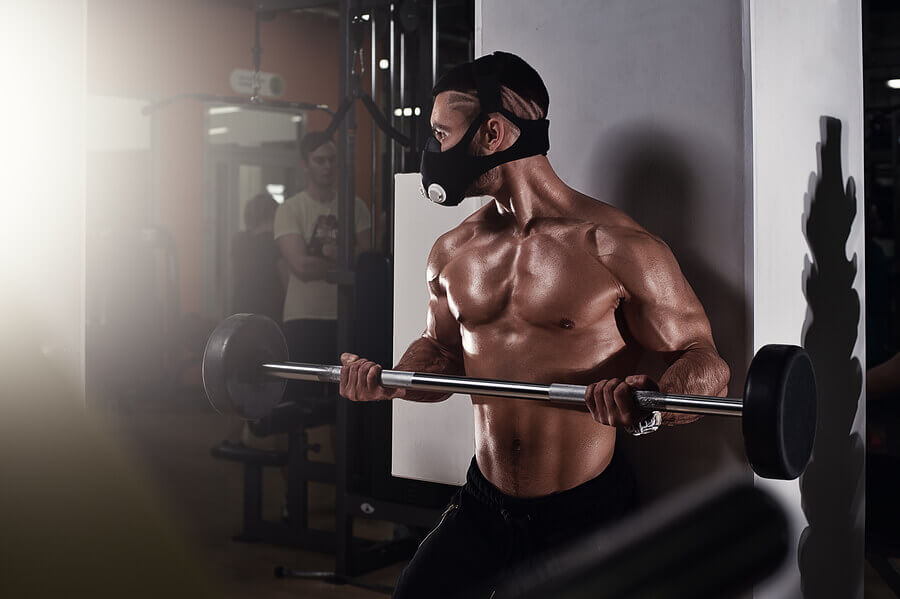Elevation Training Masks to Improve Sports Performance

You may have seen athletes wearing an elevation training mask? Elevation training masks are one of the latest accessories available to help improve athletic performance. In this article, we’ll share all you need to know about this new technology.
What are elevation training masks?
Elevation training masks are used to replicate altitude exercises performed by professional and elite athletes.
Created in the United States, elevation training masks are used in various disciplines. They’re not used for weight-loss or to tone muscles. So, what can we use them for? They’re actually used to improve respiratory capacity and resistance.
It replicates high altitude exercises in order to expand the diaphragm and increase resistance.
There are many ‘famous’ athletes who use elevation training masks in different disciplines including cross-fit, UFC, Ironman, American football, cycling, and soccer.
It’s a fact that at high altitudes, oxygen is less dense and as a result, the body needs to work harder. Since there is less oxygen the body needs to adapt to become more efficient. That’s the main goal of athletes who use the elevation training masks.
The reduction of the concentration of oxygen activates a hormone called erythropoietin (better known as EPO) to increase the number of red blood cells and circulating hemoglobin. This guarantees the supply of oxygen to the muscles.

Breathing and elevation training masks
Athletes must spend several weeks at a certain altitude in order to obtain the positive results that occur when exercise is performed with low levels of oxygen. There is a famous example concerning football in Bolivia. The national team plays in the city of La Paz which is 3,640 meters above sea level.
Opposing teams from different countries must arrive in Bolivia a few days before the match in order to adapt to the lack of oxygen. They must also perform specific exercises in order to prepare. Even with preparation, opposing teams usually agree that it’s almost impossible to run properly at such high altitudes.
However, elevation training masks don’t replicate the conditions of high altitude. Furthermore, they don’t produce physical adaptations. So, what are they used for? The answer is to make breathing a little more difficult.
Rather than simulating conditions similar to being thousands of meters above sea level, they actually restrict the user’s ability to breathe.
Breathing
The subject of breathing is always up for discussion in the fitness world. Some professionals and coaches recommend “breathing correctly”. This implies deep breaths in order to reduce the heart rate and to calm the nervous system.
Others recommend short choppy breaths with the aim of training to the max by preventing the body from relaxing during exercise.
Elevation training masks restrict inhalation and they reinforce breathing patterns. They also change the muscle movements required for receiving more oxygen and eliminating carbon dioxide.
As a result, users have to work harder in order for oxygen to reach their lungs. This also means that they’ll have less energy to train. The mask ‘forces’ users to train with lower intensity and speed.
So, are elevation masks useful?
Although they seem to be ‘in’ right now in the fitness world, some experts claim that instead of being beneficial they may actually be quite harmful to the athletes that use them. Imagine trying to drive a Formula One car with deflated tires! This doesn’t allow you to take full advantage of the car, and in the same way, masks may not allow you to take full advantage of your body.

For now, there are no studies to support the use of elevation training masks. Therefore, it cannot be said definitively whether they are beneficial or not.
It seems as if the mask is simply a new, affordable tool that has gained a large following in the fitness world. However, the true benefits have not yet been proven.
One reason that many people are against the training masks is that they can cause hypercapnia. They can also increase the amount of carbon dioxide in the body causing tachycardia, loss of consciousness and convulsions. If you choose to use the training mask it should always be under the supervision of a professional.
You may have seen athletes wearing an elevation training mask? Elevation training masks are one of the latest accessories available to help improve athletic performance. In this article, we’ll share all you need to know about this new technology.
What are elevation training masks?
Elevation training masks are used to replicate altitude exercises performed by professional and elite athletes.
Created in the United States, elevation training masks are used in various disciplines. They’re not used for weight-loss or to tone muscles. So, what can we use them for? They’re actually used to improve respiratory capacity and resistance.
It replicates high altitude exercises in order to expand the diaphragm and increase resistance.
There are many ‘famous’ athletes who use elevation training masks in different disciplines including cross-fit, UFC, Ironman, American football, cycling, and soccer.
It’s a fact that at high altitudes, oxygen is less dense and as a result, the body needs to work harder. Since there is less oxygen the body needs to adapt to become more efficient. That’s the main goal of athletes who use the elevation training masks.
The reduction of the concentration of oxygen activates a hormone called erythropoietin (better known as EPO) to increase the number of red blood cells and circulating hemoglobin. This guarantees the supply of oxygen to the muscles.

Breathing and elevation training masks
Athletes must spend several weeks at a certain altitude in order to obtain the positive results that occur when exercise is performed with low levels of oxygen. There is a famous example concerning football in Bolivia. The national team plays in the city of La Paz which is 3,640 meters above sea level.
Opposing teams from different countries must arrive in Bolivia a few days before the match in order to adapt to the lack of oxygen. They must also perform specific exercises in order to prepare. Even with preparation, opposing teams usually agree that it’s almost impossible to run properly at such high altitudes.
However, elevation training masks don’t replicate the conditions of high altitude. Furthermore, they don’t produce physical adaptations. So, what are they used for? The answer is to make breathing a little more difficult.
Rather than simulating conditions similar to being thousands of meters above sea level, they actually restrict the user’s ability to breathe.
Breathing
The subject of breathing is always up for discussion in the fitness world. Some professionals and coaches recommend “breathing correctly”. This implies deep breaths in order to reduce the heart rate and to calm the nervous system.
Others recommend short choppy breaths with the aim of training to the max by preventing the body from relaxing during exercise.
Elevation training masks restrict inhalation and they reinforce breathing patterns. They also change the muscle movements required for receiving more oxygen and eliminating carbon dioxide.
As a result, users have to work harder in order for oxygen to reach their lungs. This also means that they’ll have less energy to train. The mask ‘forces’ users to train with lower intensity and speed.
So, are elevation masks useful?
Although they seem to be ‘in’ right now in the fitness world, some experts claim that instead of being beneficial they may actually be quite harmful to the athletes that use them. Imagine trying to drive a Formula One car with deflated tires! This doesn’t allow you to take full advantage of the car, and in the same way, masks may not allow you to take full advantage of your body.

For now, there are no studies to support the use of elevation training masks. Therefore, it cannot be said definitively whether they are beneficial or not.
It seems as if the mask is simply a new, affordable tool that has gained a large following in the fitness world. However, the true benefits have not yet been proven.
One reason that many people are against the training masks is that they can cause hypercapnia. They can also increase the amount of carbon dioxide in the body causing tachycardia, loss of consciousness and convulsions. If you choose to use the training mask it should always be under the supervision of a professional.
All cited sources were thoroughly reviewed by our team to ensure their quality, reliability, currency, and validity. The bibliography of this article was considered reliable and of academic or scientific accuracy.
- Porcari, J. P., Probst, L., Forrester, K., Doberstein, S., Foster, C., Cress, M. L., & Schmidt, K. (2016). Effect of wearing the elevation training mask on aerobic capacity, lung function, and hematological variables. Journal of Sports Science and Medicine. https://doi.org/10.1519/JSC.0000000000001184
This text is provided for informational purposes only and does not replace consultation with a professional. If in doubt, consult your specialist.








